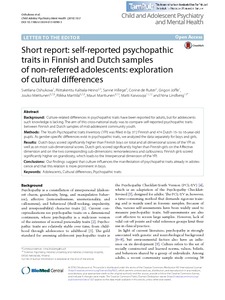Short report: self-reported psychopathic traits in Finnish and Dutch samples of non-referred adolescents: exploration of cultural differences
Oshukova, Svetlana; Kaltiala-Heino, Riittakerttu; Hillege, Sanne; de Ruiter, Corine; Joffe, Grigori; Miettunen, Jouko; Marttila, Riikka; Marttunen, Mauri; Kaivosoja, Matti; Lindberg, Nina (2016)
Oshukova, Svetlana
Kaltiala-Heino, Riittakerttu
Hillege, Sanne
de Ruiter, Corine
Joffe, Grigori
Miettunen, Jouko
Marttila, Riikka
Marttunen, Mauri
Kaivosoja, Matti
Lindberg, Nina
2016
Child and Adolescent Psychiatry and Mental Health 10
3
Lääketieteen yksikkö - School of Medicine
This publication is copyrighted. You may download, display and print it for Your own personal use. Commercial use is prohibited.
Julkaisun pysyvä osoite on
https://urn.fi/URN:NBN:fi:uta-201604261481
https://urn.fi/URN:NBN:fi:uta-201604261481
Kuvaus
BioMed Central open access
Tiivistelmä
Culture-related differences in psychopathic traits have been reported for adults, but for adolescents such knowledge is lacking. The aim of this cross-national study was to compare self-reported psychopathic traits between Finnish and Dutch samples of mid-adolescent community youth.
Methods
The Youth Psychopathic traits Inventory (YPI) was filled in by 372 Finnish and 474 Dutch 15- to 16-year-old pupils. As gender-specific differences exist in psychopathic traits, we analyzed the data separately for boys and girls.
Results
Dutch boys scored significantly higher than Finnish boys on total and all dimensional scores of the YPI as well as on most sub-dimensional scores. Dutch girls scored significantly higher than Finnish girls on the Affective dimension and on the two corresponding sub-dimensions: remorselessness and callousness. Finnish girls scored significantly higher on grandiosity, which loads to the Interpersonal dimension of the YPI.
Conclusions
Our findings suggest that culture influences the manifestation of psychopathic traits already in adolescence and that this relation is more prominent in boys.
Methods
The Youth Psychopathic traits Inventory (YPI) was filled in by 372 Finnish and 474 Dutch 15- to 16-year-old pupils. As gender-specific differences exist in psychopathic traits, we analyzed the data separately for boys and girls.
Results
Dutch boys scored significantly higher than Finnish boys on total and all dimensional scores of the YPI as well as on most sub-dimensional scores. Dutch girls scored significantly higher than Finnish girls on the Affective dimension and on the two corresponding sub-dimensions: remorselessness and callousness. Finnish girls scored significantly higher on grandiosity, which loads to the Interpersonal dimension of the YPI.
Conclusions
Our findings suggest that culture influences the manifestation of psychopathic traits already in adolescence and that this relation is more prominent in boys.
Kokoelmat
- Artikkelit [6140]
